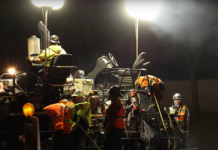In a precedent setting move Tuesday evening, the Maricopa City Council passed the hat, Councilman Will Dunn’s baseball cap, in order to select a member to fill the vacant seat on the council. Phyllis Von Fleckinger, who recently resigned for health reasons, had been elected to a four-year term.
Vice Tribal Chair of the Ak-Chin community, Delia Carlyle, was drafted from the audience to pass the hat to council members Edward Farrell, Kelly Haddad and Vice-Mayor Brent Murphree. The hat contained three slips of paper, one that read “four-year term”. Haddad, whose two-year term will now be extended, drew that particular slip.

Delia Carlyle offers “the hat” to Edward Farrell while Mayor Anderson (seated) looks on. Vice-Mayor Murphree (center) and Kelly Haddad (left) await their turns to draw a slip from the hat.
Councilman Will Dunn made the motion to extend one councilman’s term, utilizing a blind draw procedure, and then to appoint a two-year term candidate. “The person we pick is required to run for election. Then it’s in the citizens’ hands. They elected these guys. It would look wrong, sound wrong if we didn’t give an elected official a longer term.”
Steve Baker remarked, “I think we should fill the remainder of Phyllis’s term and move on.”
Although the council had voted, after a previous special meeting, to reconsider the vacancy in order to gain public input, only two Maricopa residents spoke on the matter.
Joe Estes stated, “I understand this is a difficult decision. There is a good argument both ways. I think the cleanest way is to just appoint someone and move on.”
Anthony Smith told the council, “I encourage you to move with speed. As elected officials you were given rights and privileges. You will be setting precedent, however.”
Previously Haddad, Farrell and Murphree had recused themselves from voting, citing a conflict of interest.
City Attorney Denis Fitzgibbons sought and received a legal opinion from the general counsel for the League of Arizona Cities and Towns, David Merkel. His opinion was as follows: “Factually, members of the city Council serve without compensation of any sort, either monetary or proprietary. Consequently, there can be no ‘substantial’ interest by definition and thus no conflict of interest.”
Applications for the two-year council vacancy will be available at City Hall and online. According to City Manager Rick Buss, the application period is “typically 30 days.” The deadline will be 5 p.m. on Friday, October 28.
Mayor Kelly Anderson stated, “I would really like to see us make an appointment on November 1.” The council plans to interview candidates on that date unless the number of applicants is extensive. If so, a special meeting will be called for interviewing.
Public Works Projects
Acting Director Robert Jackson received council acceptance of the streets in various parcels in Maricopa Meadows and the Villages at El Dorado into the city’s street / road maintenance system. According to Jackson, “These are the leftovers from the transition from county to city. Hopefully, from now on it will be easier.”
The council approved the Small Area Transportation Study (SATS), which identifies significant transportation elements in this area. It details the number of roadways needed to get from one place to another. It also addresses a grade separation or possible overpass for the railway crossing in downtown Maricopa.

Director Robert Jackson explains various public works projects to the council members, including (left to right) Steve Baker and Kelly Haddad.
Jackson explained, “This is a framework to start from. That’s all we intended it to do. It does have flaws in it because of some of the assumptions we made.” He explained that, at the time the study began, the assumption was that the city would do 300 permits a month. That figure has doubled due to the hypergrowth in Maricopa. The state is already being approached about another SATS study.
Ralph Pew, representing the Coalition of Homebuilders, added, in reference to the SATS study, “We hope this is an opportunity to start talking about street widths and the ultimate configuration of roads, particularly Farrell Road.”
Referring to the flooding and drainage problems south of the high school and Honeycutt Avenue, Jackson explained that the county originally approved Alterra and Maricopa Meadows as well as the drainage report for that area. “Fixing the problem has become a city problem,” he stated.
Police Services Study
Finance Director Roger Kolman explained some of the procedures involved in this study. Carroll Buracker & Associates, who were awarded the contract by the council, worked with both Queen Creek and Apache Junction. “I spoke to the city managers of both cities, and both highly recommended Carroll Buracker. In fact they have rehired them,” indicated Kolman.
The study will take three to four months. The firm will be looking at a multitude of county documents. The council members and city staff will be interviewed regarding their visions of a city police department and the facilities needed for it. The results of the Queen Creek study will be provided to the council.
Additional Modular Building
Council approved an agreement with GE Modular Space to provide a building for the interim City Hall. Buss thanked Councilman Baker for helping find a suitable modular.
“There are scarcities of buildings on the market due to Hurricane Katrina and a project at Palo Verde,” explained Buss. The handicapped accessible facility will house building inspectors and provide an additional conference room.
Voting Precinct Change
City staff recommended that one to three new voting sites be selected, ranked and submitted to Pinal County and the Department of Justice with population data and projections. It is unclear whether the county has either the equipment or the staffing available for an increased number of sites.
Suggested sites to be utilized as polling places were Province’s community center, the First Baptist Church, the Villages at El Dorado clubhouse, the LDS Church and the Maricopa Community Church.
The Justice Court is no longer a feasible location due to lack of parking and the fire and sheriff’s services in that vicinity. Buss asked that recommendations be made at the next council meeting, after all sites had been contacted. “It takes a number of months to get through the Department of Justice,” he explained.
One of the problems with adding precincts is, that despite local growth, the City of Maricopa has only 3,369 registered voters in a population estimated at approximately 18,000 people. According to Buss, one of the problems is that people are unaware that this is Pinal, not Maricopa County.
Dunn emphasized, “We’ve got to get the public to get their registrations changed. We’ve got to get the word out.”
County Supervisor David Snider commended the council for the “very public process” used to fill the vacant council seat. Snider termed the action an “amazing feat of democracy and civil organization in a very short time.”
Vice-chairman Carlyle asked the council to continue working on its Good Neighbor Policy with the Ak-Chin community. “If it hadn’t been for the non-Indian farmers here 60 years ago who taught us, we wouldn’t be where we are today,” said Carlyle. She thanked the council members for their efforts and offered the hope that the cooperation would continue.



![Shred-A-Thon to take place tomorrow An image of shredded paper. [Pixabay]](https://www.inmaricopa.com/wp-content/uploads/2024/03/shredded-paper-168650_1280-218x150.jpg)












![Shred-A-Thon to take place tomorrow An image of shredded paper. [Pixabay]](https://www.inmaricopa.com/wp-content/uploads/2024/03/shredded-paper-168650_1280-100x70.jpg)
